 |
207 SQUADRON ROYAL AIR FORCE HISTORYHonouring those who helped
|
For the weekend of the 60th Anniversary of VE Day, a group from 207 Sqn RAF Association were invited to Meeuwen-Gruitrode in the Province of Limburg, Belgium, for the dedication of a memorial to the Corless crew of 207 Sqn RAF (EM-W ME683) all killed on the Wesseling Raid of 21/22 June 1944. We also visited the crash site near Dorne, Limburg, of another 207 Sqn crew Solly's Sinners (EM-M LL973) lost on the same raid, in which three crew were killed, two were taken POW and two evaded. One of the POWs and one of the evaders from that crew were in the group.
The visit in the Province of Limburg was guided by Danny Vanstraelen-Reumers, grandson of Frank Haslam snr's helpers, Gerard and Helena Delsaer-Guerts. Gaston Delsaer, Gerard's brother, was shot by the Germans in April 1944 for resistance activities. Another brother, Michel, escaped to England and joined the Belgian SAS. Gerard's parents hid escaped Russian prisoners. Such was the patriotism of many gallant Belgians.
During our stopover in Brussels, on our way to Hasselt, we visited the grave in Brussels Town Cemetery of Flt Lt Peter Anderson DFC RCAF, kia 11 April 1945, pilot of Lancaster ME472 EM-O, hit over Leipzig and crashed at Burgbrohl, N of Koblenz, the last casualty on 207 Sqn in WW2.
Also in the capital we paid our respects to those who assisted airmen who had been shot down in Belgium, when we visited the National Basilica at Koekelberg, a suburb of Brussels
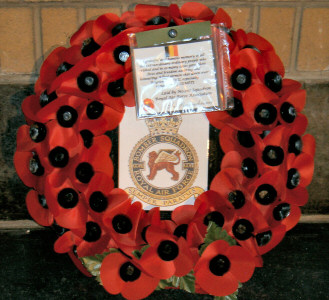 |
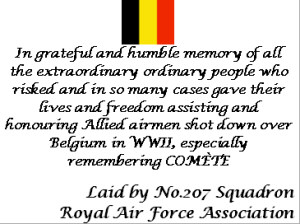 Our wreath was laid by on our behalf by Diana Morgan, after a silence for prayer and reflection following the reading of the dedication. |
39 members of 207 Squadron evaded capture after going missing on operations in World War II. Flt Lt Denys Street was one of those executed by the Nazis after recapture following the 'Great Escape' from Stalag Luft III in March 1944. A number of 207 Sqn POWs were held for a time in Buchenwald.
The Comet Line badge in the bottom right-hand of one of the windows represents a falling plane, the star represents those in the Comet line which aided Allied evaders and escapers, especially airmen, to get back. The window was unveiled in October 1953 by Prince Albert, later King Albert II. It was paid for by money received by the Belgian government in exile from the British Government, some of which went to create university scholarships, some towards the window. It was designed by Belgian artist Anto Carte (1886-1954).
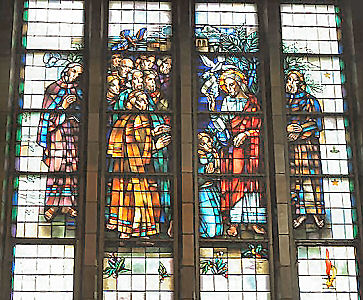 the window containing the Comet Line badge, bottom right |
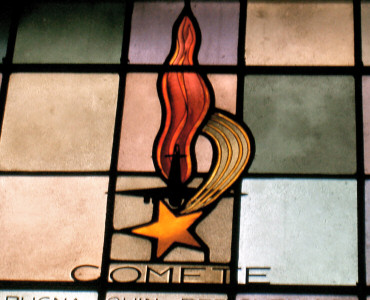 beneath the badge is the motto Pugna Quin Percutias Fight Without Blows |
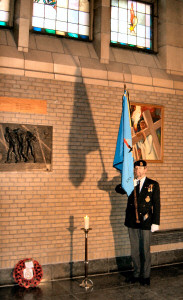 the Comet Line badge can be seen above the Standard |
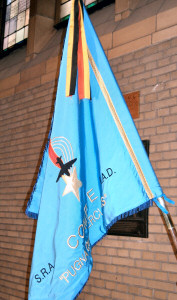 the Comet Line Standard |
Royal Air Forces Escaping Society plaqueBeneath the window is the Royal Air Forces Escaping Society plaque: “On the 21st June, 1981, this plaque was dedicated to the countless brave men and women of enemy occupied countries who, during WWII (1939-1945), without thought of danger to themselves, helped 2803 aircrew of the Royal Air Force and Commonwealth air forces to escape and return to their country and so continue the struggle for freedom. Many paid with their lives, many more endured the degradation of concentration camps. Their names are remembered in equal honor with those who were spared to fight a longer battle. To mark its debt of gratitude, the Royal Air Forces Escaping Society erected this memorial as a lasting tribute and also to serve as an inspiration to future generations.” |
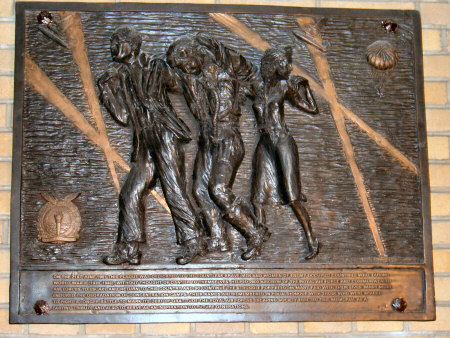 |
The plaque was designed and created by Elizabeth Harrison MBE, former Secretary of RAFES and shows an airman who has baled out being aided by helpers. The plaque is also in St Clement Danes RAF Church London, RAF Museum Hendon, War Museums in Ottawa, Canada & Canberra, Australia, Musée de l'Armée at the Hôtel des Invalides Paris, and the National Resistance Museum Overloon, Netherlands.
NadineWe were met by Andrée “Nadine” Dumon OBE, who as a very young woman acted as a courier to guide airmen down the Comet Line. In August 1942 she was arrested and spent the rest of the war in prison, escaping briefly once, and then in Ravensbruck. We were honoured and very grateful to meet Nadine and some of her Comet Line colleagues. With her was Claire, the daughter of Baron Greindl (his code name was Nemo), M. Louis van Lierde, M. André Henry de la Lindi (see below) and M. Freddy Roiseux, Comet Line Standard Bearer, whose father 's code name was 'the Plumber'. In our party was an old friend of theirs, Mrs Diana Morgan, widow of Bryan Morgan who evaded after being shot down on 460 Sqn on the Mailly-le-Camp raid of 3/4 May 1944. For many years Bryan was Press Officer of the RAF Escaping Society. |
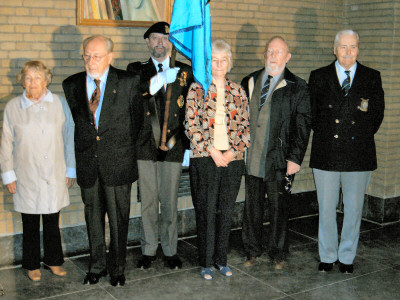 'Nadine' - M. van Lierde - M. Roiseux - Mrs Morgan - M. de la Lindi - 207 Sqn evader in Belgium Jun-Sep 1944 Frank R Haslam |
In all a total of about 800 Allied soldiers and aircrew were helped by the escape line known as Comète, to reach freedom and continue fighting the war.
All this came at a terrible price for those Belgians who were caught, and their families. Most ended up in the nightmare of Nazi concentration camps where many died of illness and starvation. Some were executed in prison and many of the women were sent to the Ravensbruck concentration camp, north of Berlin, as Nacht und Nebel (Night & Fog) political prisoners, intended to disappear inside the deadly system. Many of the network's helpers died and among those who survived others suffered for the rest of their lives in mind and body from the cruelty suffered whilst imprisoned.
This is what "Nadine", said to the 207 Sqn Association group at the laying of wreath in Koekelberg Basilica, Brussels, May 6 2005:
"Comet began in '41, begun by a woman aged about 25 [Andrée De Jongh]. She decided to go to see the British Consul in Bilbao to ask him if he can help if she comes there with English people, at that time mostly British soldiers. After a long discussion with the Consul, he accepted. So she came back to Belgium and returned straight back to Bilbao with three British soldiers. To do that she went to Paris, then Bordeaux by train, and then take another little train to St Jean de Luc. She has to cross the Pyrenees, the River Bidassoa. Sometimes [crossing the river] is very easy, sometimes it is very difficult because the current is very, very strong. Then, another mountain to climb and then they were in Spain. They were safe in Spain."
"For me, I helped Monsieur De Jongh, the father of Andrée De Jongh, the young girl. I helped first in Brussels, my parents were also involved in the Resistance. The three of us were arrrested. My sister took over from me. Towards the end of the war my sister went to England as it was too dangerous for her to stay in Belgium."
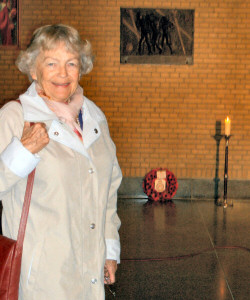 |
"When
I was working with Monsieur De Jongh, he said
"Do you want to go to Paris with some
English?". I said "Yes, that's my dream, of course!". At that time a lot of pilots and airmen were shot down. Some were hurt. One had broken his ribs? but he was strong mentally so it was no problem." "I went to Paris with them, sometimes with three of them, sometimes two. Of course I had a lot of problems with them sometimes, because they know not a word of French, so I have to say "Please, I am with him because he is mute" or I have to find something [some excuse]." "Then I was arrested and I spent nearly three years in prison and in concentration camps, in the end I was in Ravensbrück and in Matthausen, in a very bad state. We were Nacht und Nebel, just to 'disappear'. We travelled in cattle trucks, it was very bad. Without anything to eat, without drink, very, very tight - it was a very, very difficult journey .... I was lucky, I came back but my father died on 9th February 1945, in a camp in a very bad condition." |
André Henry de la Lindi: "I would like to say thank you very much for your presence here in Belgium for the commemoration to the Comet Line. I am here because my father [Paul Henri de la Lindi] was the first officer pilot [Royal Belgian Air Force] who passed through the line in February '42. When he arrived in England after 32 or 33 days, it was very successful at that time."
"The British authorities and Belgian authorities in England told him he was too old to fly again, he was 36. Then he accepted a mission in Belgium, he did parachute training, he was dropped near Ciney in Belgium, not far from Namur, in September '42. He created a new network in the region of Liege. He was arrested by a German officer whose name was Schäfer. This man had done parachute training in England with him - he was arrested in February '43. He had a process [trial], he was tortured very badly and he was shot on 31 May '43 by the Germans in the Citadelle of Liege. That is in a few words the story of my father."
Links
Escape Line Research & Remembrance
Memorial Society - Comet Line pages
RAF Chapel
| Also in
the Basilica is a chapel dedicated to the RAF to
which we were privileged to have access. Behind the
altar are stained glass windows and mounted on the
wall squadron badges of those units in which there
was a significant Belgian presence. The visiting veterans from 207 Sqn RAF Association are shown here with Mme Dedée Dumon (Nadine of the Comet Line) and Comet's Standard Bearer. To her left is a 207 Wireless Operator who was hidden by a Belgian family for 13 weeks in 1944. Second from the right is a former Flight Commander on 207 who went on to be CO of 138 Sqn RAF, one of the 'secret' Tempsford squadrons which transported agents into occupied Europe. |
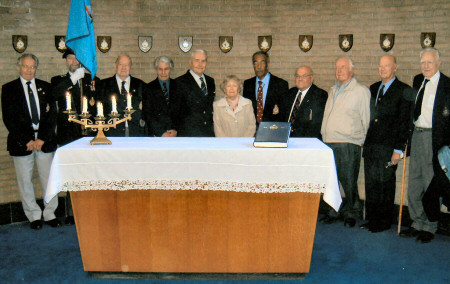 |
An information leaflet provided in the Chapel gives the following description:
THE ANGLO BELGIAN AIR FORCES MEMORIAL WINDOWS
The Belgian Branch of The Royal Air Forces Association has taken the initiative to create a fund to finance and instal nine stained glass windows in a chapel of the National Basilica. The windows serve as a reminder of the gallantry not only of the Belgians who served in The Royal Air Force in World War II but also of the heroism of those who organised the escape lines for aircrews who had been shot down to return safely to the United Kingdom. Much is also owed to those Belgian Agents who, at great risk to themselves, supplied intelligence reports which undoubtedly saved the lives of many aircrew.
The windows also symbolise the long standing spirit of comradeship between our two nations, in particular the Belgian Air Force and The Royal Air Force. By paying homage to all those Belgians who gave their lives in the service of The Royal Air Force it is earnestly hoped that future generations will pause and reflect on hardships endured and sacrifices made to maintain freedom and liberty.
The chapel in which the windows are displayed is one of five small chapels in the north transept of the Basilica.
A SHORT DESCRIPTION OF THE CENTRAL WINDOWS
The focal point of the central window is the Royal Air Force emblem set in a background of various shades of blue. The radiant sun, from which emerges a white dove of peace carrying an olive branch, sends forth its rays washing the national flags of the United Kingdom and Belgium in the glorious colours of the rainbow. The whole concept evokes a sense of timeless majesty in the creation of the universe and mankind's place in the scheme of things.
The window on the left represents Jesus Christ with outstretched arms sending forth his spirit of light, love and peace to a warring humanity fighting in outer darkness. The window on the right depicts a Belgian airman in the uniform of The Royal Air Force listening to the words of Jesus. He is surrounded by birds flying in an anti-clockwise direction signifying the spiritual qualities of his immortal soul reaching upwards in its pilgrimage towards God. A lone agent parachutist falls from a moonlit sky.
THE ARTIST
Born in Poperinge in 1930, Madame Theodora Veranneman belongs to a long line of notable artists, Alphonse and Louis Veranneman being only two, specialising in works of a religious nature. She studied painting under Leon Pringels and architecture under Malcause at the Academie des Beaux Arts de St. Gilles.
Her talented work exudes a freshness and a vivacity which exhilarates and is in great demand. She has realised many important commissions for churches in Belgium including the National Basilica. Her reputation as an internatinal artist is further enhanced by the creation of The Royal Air Force memorial windows.
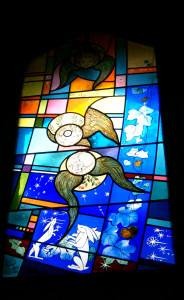 |
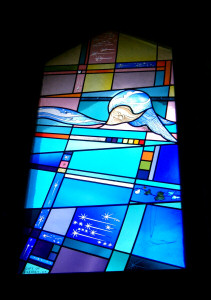 |
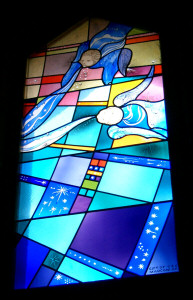 |
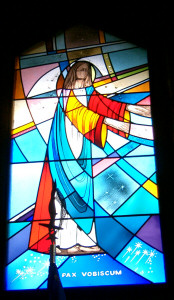 |
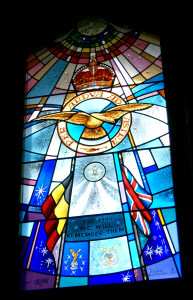 |
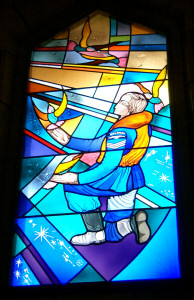 |
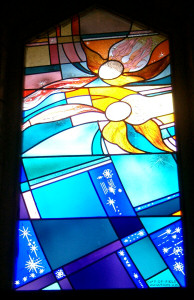 |
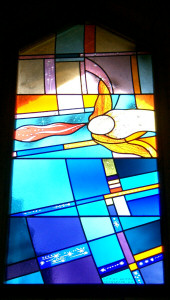 |
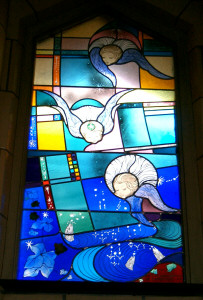 |
If you can
provide more information on the symbolism in these windows
and the correct sequence, left to right, please contact the editor
BASILICA OF THE SACRED HEART, KOEKELBERG, BRUSSELSWhen standing on one of the hills surrounding the centre of Brussels, one can always see the dome of the Basilica. The Basilica of the Sacred Heart (situated in the Suburb of Koekelberg) is labelled "the national Basilica of Belgium". It was built to remember the 75th anniversary of the Belgian independence. In 1905 King Leopold II laid the first stone. According to the plans of the architect Langerock it was to become a gigantic neo-gothic church. The initial plans were stopped during World War I. However, by 1919 the developers had changed their plans and architect. A new architect, called Van Nuffel was asked to construct a modern prayer house. |
 |
To the people of Brussels and Belgium it seemed that the Basilica would never be finished. Moreover, the construction of the church depended entirely on donations made by believers and these did not always yield the expected funds. The church was eventually finished in the late 1960s with the construction of a dome dedicated to the war victories of 1918 and 1944.
The interior decoration is in 1930s Art Deco style with extensive use of marble. Since March 1997 visitors can climb into the dome from where one can enjoy a beautiful panoramic view over Brussels and its surrounding area. The Basilica is said to be the fourth largest church in the world, after Saint Peter's in Rome, Saint Paul's in London and Saint Maria del Fiore in Florence.
The visitors from 207 Squadron RAF Association thank the staff of the National Basilica for their kindness shown during our visit.
The escape network called Comète
Provided by RAYMOND ITTERBEEK, Président du Comité
Consultatif Logistique de l'lnstitut des Veterans
(from the Summer 2004 issue of AFEES Communications)
In spite of the existence of the Treaty of Non Aggression, German troops invaded Belgium on 10th May 1940. The Belgian Army tried valiantly to defend their country, but by 28th May, Belgium capitulated to the superior strength of the German Army and it was at this point that the Belgian people decided to do everything possible to deter and annoy the occupying army.
One of these Belgians was a young girl of 24 years old - Andrée De Jongh. She was a Red Cross volunteer working as an ambulance driver for a hospital in Bruges where many of the wounded English soldiers were cared for. She realised that unless they were helped to escape they would probably be sent to prisoner of war camps. But she also knew that whoever sheltered or helped them would risk the death penalty!
With the help of a friend who gave her the address of a Belgian friend who lived at Anglet, a small village near the Spanish frontier, she decided to go and see the British Consul at Bilbao. During such a journey she knew she would be facing risks, encountering German police or traitors who were willing to help the Germans.
She wanted to realise a seemingly foolish dream, but with optimism and courage and in spite of the many obstacles and discussions, she was eventually put in touch with the British Consul in Madrid. He promised to help the "Boys" who wanted to escape once they were over the Spanish frontier.
Many, many people, both Belgian and French, helped with this Resistance project. There were those who helped by lodging the airmen on their journey across Belgium and France, those who made false documents and those who sheltered the guides along the escape route.
This escape route started from Brussels and passed through Paris, Bordeaux, St. Jean de Luz, crossed the Bidassoa and over the Pyrenees to reach Spain where they were taken charge of by the British. The escapees were then sent to England where they rejoined the Air Force and continued fighting. They also boosted the morale of the other airmen, showing that there was always a chance to survive.
The route was frequently changed during the war years to confuse the Germans and their collaborators. During the second half of 1944 it was no longer possible to escape through Spain, so Comète became Operation Marathon and they hid the "Boys" in the Belgian Ardennes, chiefly at Porcheresse and in France in the forest of Fréteval near Blois.
Throughout the war men and women rose to the occasion to replace other helpers who were arrested and no one will ever know the exact numbers of Resistant Helpers who sheltered, hid, provided false documents, food and guided those young men who fell out of the sky!
More than 750 men were saved by Comète but about the same number of French and Belgian Resistance workers died in prison and concentration camps. Others were shot, beheaded or assassinated or died from the terrible conditions prevailing in the camps.
After the war the members of Comète founded an association to unite all those who had survived. In England, America, Canada and Australia, other associations were created by the escapees in order to remember with gratitude their Helpers and if necessary, to be able to help the Helpers. In this way warm contacts were made and solid friendships established. Annual reunions continue to this day in various countries through which friendly links are formed in order to remember and honour those who have died.
| After the war King
Baudouin conferred the title of Countess on Andrée
De Jongh for her courage and determination throughout
the war and during her long captivity. Also for the
years she spent caring for lepers after obtaining her
nursing diploma. In this photograph taken in the Basilica on Oct 11 1953 (the anniversary of the date that 11 Comète members faced a firing squad) from left: two not known - Rene Ponty, founder of the Phantom Train Association - Baronne Denny - Ann Brusselmans - Tante Go (Mme de Greef) - Yvon Michels and Dedée de Jongh. |
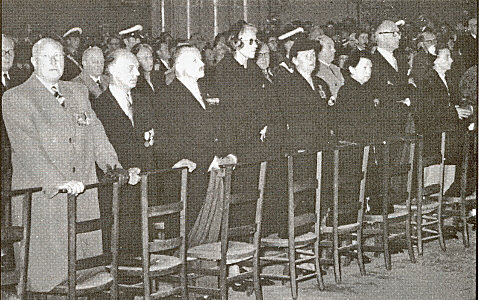 |
A memorial plaque of the RAF placed under a stained glass window in the Basilica of Koekelberg bears the Comète sign to commemorate the help given to Allied airmen. Every year and for 60 years, wreaths and flowers have been placed at the foot of the memorial to honour the dead and numerous foreign representatives have always attended the ceremony.
In England several war museums trace and record the help given by occupied countries and Comète occupies an important place in these displays. In the Malton Museum [Eden Camp] in Yorkshire a very complete history of the Comète Escape Network can be seen.
Links:
207 Squadron RAF History
Royal Air Forces Escaping Society 1945-95
including RAFES Museum, East Kirkby
Air Forces Escape & Evasion Society
(the American equivalent of RAFES)
CRAFES - the ongoing Canadian section of
RAFES
Escape
Lines Memorial Society (ELMS)
Eden Camp Hut 9
page last updated 2 Aug 2005; 28 Dec 13